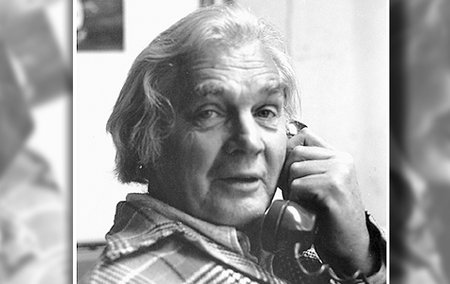Roy John Britten, a pioneering molecular biologist who studied the organization of the animal genome, and Caltech's Distinguished Carnegie Senior Research Associate, Emeritus, passed away on January 21. He was 92.
Britten began his academic career as a physicist, but soon became interested in the fundamental characteristics of animal DNA. He began working at Caltech's Kerckhoff Marine Laboratory in Corona del Mar in 1971 and from then on studied basic aspects of the genome and its evolution.
Britten's research on the organization and evolution of DNA sequences and on gene expression during development helped lay the foundations for modern genomics, developmental biology, and the study of regulatory-gene evolution.
"He was one of the truly brilliant people I have known," says Eric Davidson, the Norman Chandler Professor of Cell Biology at Caltech, who worked closely with Britten for many years. One of Britten's greatest early contributions, Davidson says, was his discovery in 1968 that an animal's genome-including ours-contains sequences of DNA that are repeated throughout, in addition to sequences that exist only as single copies. This finding was a "timeless intellectual tour de force," Davidson says.
To make this discovery, which is now considered a basic fact of genomics, Britten studied how a genome that is broken up into short, single-stranded segments of DNA combines back into double-stranded molecules, a process called renaturation. To renature, the "letters" that spell out the sequences in each DNA fragment have to find their complementary partners.
If these sequences are repeated-that is, if there are multiple copies of this sequence in the genome-then it will be easier for the fragments to find their partners. As a result, renaturation of repeated sequences happens more rapidly, at a rate that depends on the number of copies of the sequence.
But if there is only one copy of each particular sequence per genome, then it will take longer for the sequences to find their partners. Renaturation will therefore be slower, taking place at a rate that depends directly on the size of the genome.
By studying mammalian DNA and determining its rate of renaturation, Britten and his colleague David Kohne deduced that some DNA sequences are repeated. These experiments also allow biologists to determine how many sequences in a genome are repeated.
In 1969, Britten and Davidson published the first model of a gene regulatory network-a web of interacting regulatory genes that biologists now know control the development of an animal from an embryo to an adult. Regulatory genes are segments of DNA that determine when and where other genes are turned on or off. Now, more than 40 years later, biologists have determined experimentally how these gene regulatory networks-which have many of the properties first predicted in 1969-function to control the process of development.
In 1971, Britten and Davidson published another landmark paper concluding that the evolution of an animal's body plan-whether it has legs or fins, for instance-depends on changes in how genes are regulated during development. This concept is the foundation for the now-vast field of evolutionary developmental biology, today known as "evo-devo."
For the next quarter century, Britten and Davidson continued to work closely together at Caltech to understand the role of regulatory genes in development and the fundamental processes of how genes are expressed. Starting in the mid-1990's, Britten became interested in the evolution of primate DNA sequences, to which he devoted the rest of his scientific life. He remained scientifically active until his death, publishing papers past his 90th birthday.
Britten was born in 1919 in Washington, D.C., and grew up in Arlington, Virginia. His father, Rollo, was a statistician with the Public Health Service, and his mother, Marion Hale (known as "Mimi"), worked at the National Research Council. Both parents were intellectuals, helping to foster Britten's interest in science as a child. Britten shared a basement chemistry lab with his brother.
In 1940, he went to study physics at the University of Virginia. During World War II, Britten worked on the Manhattan Project before returning to school in 1946. "As a committed pacifist, he was always pleased to say that his particular project was a complete failure," says Ken Britten, his son.
He went to graduate school at Princeton University, where he married Barbara Hagen, with whom he had his two sons. They divorced in 1976. Britten later married Jacqueline Reid in 1986.
After receiving his PhD in nuclear physics in 1951, he switched fields to biophysics, joining the Department of Terrestrial Magnetism at the Carnegie Institution in Washington, D.C., where he was a staff member until 1971. It was there that he did his seminal work on DNA renaturation, as well as helped to develop new technology and research methods in molecular biology.
Britten came to Caltech with Davidson in 1971 as a visiting associate, working at the Kerckhoff Laboratory. He became a senior research associate in 1973 and in 1981 was named the Distinguished Carnegie Senior Research Associate in Biology. He became emeritus in 1999. In 1991, he began an appointment as an adjunct professor at the University of California, Irvine.
Like his parents and his sons, Britten was an avid sailor, having sailed all over the world. For several years, he lived on his schooner, which was moored in Newport Bay in Southern California near the Kerckhoff Marine Laboratory. He also played the flute and enjoyed oil painting and writing science fiction. "He was an unusually talented man," Davidson says. But above all, it was his intelligence that set him apart. "He did not suffer fools lightly," Davidson recalls.
Britten was elected to the National Academy of Sciences in 1972. He was also a Fellow of the American Association for the Advancement of Science and a Fellow of the American Association of Arts and Science.
He is predeceased by his wife, Jacqueline, who died in 2001. His first wife, Barbara, died in 2000. He is survived by his two sons, Greg and Ken.





